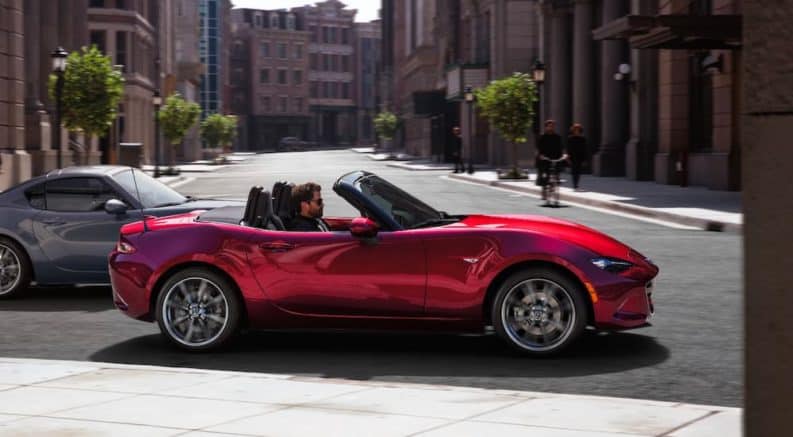The Mazda MX-5 Miata is many things to many people. A hairdresser’s car, a tic tac with an engine and a chassis, and perhaps, one of the best used car deals for those who want an easy introduction to car culture. From coast to coast, from the great plains of Texas to the rolling hills of Pennsylvania, these little gems of the automotive world can be found at your local Mazda dealer. Having been in continuous production since 1989, the Miata remains one of Mazda’s longest-running nameplates and for a very good reason. It paid homage to the great British road cars of the 1950s and 1960s while at the same time being incredibly reliable and easy to service in a way its spiritual predecessors never were. It did what was once thought impossible and did it in such a memorable way that the highlights of its 32-year history are worth getting into.
“If there’s no oil under it…”: The Miata’s Inspiration
There’s an expression in the world of cars about those made in Britain. “If there’s no oil under a British car… There’s no oil in it!” Unfortunately, fair or not, that’s the impression most buyers of British imports got back in the middle of the 20th century. To be fair, the British roadsters, often owned by servicemen who had first locked eyes with these little sporting cars while deployed in Europe during the Second World War, were a blast to drive. They were light and fun little machines in a way most American cars simply hadn’t been designed to compete with.
They were low to the ground, with slick-shifting manual transmissions often located on the floor of the vehicle. They could be had with high revving four-cylinder and six-cylinder engines and were rear-wheel drive. All of this came together to give the owners of these cars an unforgettable driving experience that would make going back to your average American car of the time a difficult task. However, the roadsters were still expensive and difficult to keep running, especially for your average American.
You’d be hard-pressed to find parts once you got your Triumph Stag or MG MGB shipped stateside. Often something as simple as a water pump could be difficult to locate and could take weeks to arrive once found. Complex engineering and labor strikes during the time of manufacturing also led to shockingly poor build quality. The aforementioned Stag, for example, used a V8 engine made by taking two 1400cc four-cylinder units and essentially welding them together down the middle. This caused the iron engine block and aluminum cylinder heads to warp as the two different metals reacted to being chemically forced together, resulting in all sorts of headaches for owners, like blown head gaskets and cracked cylinder heads.
While very entertaining, the Stag was only sold for three years in the United States and was considered a massive flop by the ailing British Leland automotive company. There was clearly a market for an automaker who could beat the Brits at their own game. To, in effect, build a better mousetrap. If you’ve read this far, you know what’s coming next…

1989: A Star Is Born
When Bob Hall, an American writer for MotorTrend whose expertise was Japanese cars, met with Mazda higher-ups in 1976, they asked him what he felt Americans would want from them going forward. When he brought up the loss of British roadsters, Kouhei Matsuda (head of Mazda at the time) was skeptical, and the idea didn’t gain much ground. However, when Hall later found himself at the head of Mazda’s American product planning division, he was in the right place at the right time to suggest the idea again.
Seeing an underserved market, the higher-ups agreed, and planning began on a lightweight little road fighter. Hall, along with designer Mark Jordan led the Mazda USA team to create the basic idea for the Miata as we would know it. They designed a small, front-engined, rear-wheel drive, drop-top in the vein of cars like the MG Midget. They pitted this design against a mid-engine front-wheel drive concept by Tokyo and a front-engine front-wheel drive option from Hiroshima. Had either of these designs won out, we would’ve seen a very different Miata on the road today.
The three teams competing against each other were known as Offline Project 55, a new strategy for bringing new cars to market for the company. The first-generation Miata, also known as the NA by enthusiasts, was introduced in 1989 as a 1990 model. Featuring pop-up headlights, a 1.6-liter four-cylinder engine, and a choice of only three colors at the outset (those being red, white, and blue), the Miata quickly became one of Mazda’s best-selling nameplates.
Icing On The Cake: Notable Models
In 1991, as a salute to the cars that helped inspire it, Mazda created the first special edition NA painted in classic British Racing Green, with a custom wooden shift knob and badging. Instantly recognizable among owners of this generation, examples remain sought after by Miata fans the world over.
Introduced with the NB (second generation) model in 1999 was the 10th Anniversary model. It came painted only in Sapphire Blue with polished chrome wheels and had something reserved for only the top-spec models at that time – a six-speed manual transmission. It also featured the new bodywork and larger 1.8-liter engine standard to that generation of Miata. The ultimate version of the NB was undoubtedly the Mazdaspeed version. Factory turbocharging done by Mazda’s performance wing allowed the little car to crank out 178 horsepower and direct it to the wheels through a limited-slip differential.
The third generation Miata (the NC, seeing a pattern here?) came to market in 2006. It remains the heaviest and largest Miata offered to this day. Featuring a 2.0-liter four-cylinder engine, it made 170 horsepower, nearly as much as the previous generation’s turbocharged Mazdaspeed model, even without the benefit of forced induction. As popular as the little roadster was, there were some people who were none too keen to drive a soft-top car all year round. Seeing this, Mazda offered an NC with a PRHT. This stands for Power Retractable Hard Top, and it quickly became a popular choice among Miata buyers.
The last and most current generation is (drumroll)… The ND. It was introduced in 2016 and is the closest in both size and weight to the original NA. Thanks to modern engineering, the ND was able to ditch the bloated styling of its former generation while retaining its sporty, fun nature. While only making 155 horsepower in its original form, the ND was updated to provide 181 in 2018. This high power and low weight allow the ND to be the fastest Miata yet (even the exalted Mazdaspeed NB) and far safer than any previous model. Like the PRHT of the NC, the ND offers a retractable hardtop model similar in design to a fastback, giving the ND a sporty, aggressive appearance and the confidence to be driven in any weather.
Take Our Advice!
There’s a darn good reason why car enthusiasts say, “a Miata is always the answer” when asked what car a person should get if they want an introduction to car culture. They are easily found all over the United States, in used car lots as far as the eye can see, and they can be repaired with metaphorical duct tape and harsh words. No matter the generation, no matter the year, you’re getting one of the best little roadsters on offer. Since 1989, the Miata has stood as an enduring example of automotive drive and passion in a rapidly changing world.





